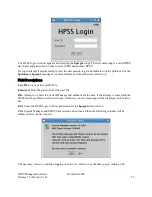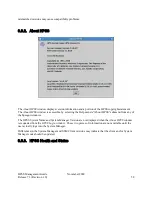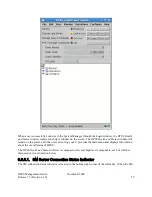
These files may be installed in any location on the SSM client machines. The user must have at least
read access to the files.
The SSM startup scripts hpssgui.pl, hpssgui.vbs, hpssadm.pl, and hpssadm.vbs provide the user with a
command line mechanism for starting the SSM client. The hpssgui.pl script is a Perl script for starting
the SSM Graphical User Interface and the hpssadm.pl script is a Perl script for starting the SSM
Command Line User Interface. These scripts work on AIX, Linux, or Windows platforms so long as Perl
is installed on the host. The hpssgui.vbs script is a Visual Basic script for starting the Graphical User
Interface and the hpssadm.vbs script is a Visual Basic Script for starting the SSM Command Line User
Interface. These scripts work only on Windows platforms.
These scripts depend on the ability to read the other files in the package. See the
hpssgui
and
hpssadm
man pages for details
.
The hpss.jar file contains the
hpssadm
and
hpssgui
program files. This is stored on the server machine
under $HPSS_PATH_BIN; the default location is /opt/hpss/bin. If the SSM source code on the server
machine is recompiled, the hpss.jar file must be redistributed to all of the SSM client machines.
The keytab is used only by the
hpssadm
program. See Section 3.3.2.3:
User Keytabs (For Use with
hpssadm Only)
on page 37
,
for details.
See Section 3.3.4:
SSM Help Files (Optiona
on page 42, for a description of the Help Files.
A writable directory is required for
hpssgui
or
hpssadm
session logs, if these are desired. The session
log is an ASCII file that stores messages generated by the
hpssadm
or
hpssgui
programs. By default, the
hpssgui
/
hpssadm
scripts do not create session logs, but it is strongly encouraged that this capability be
enabled by using the -S <location> option when running the script. The recommended location is /tmp
on UNIX-like systems or c:\tmp on Windows systems. See the
hpssgui
and
hpssadm
man pages for
more information on creating a session log. Having the session log available helps when debugging
problems with the SSM client applications. It is the first thing that the SSM developers will ask for when
someone is having problems with the
hpssgui
and/or
hpssadm
.
3.3.6. Using SSM Through a Firewall
3.3.6.1. The Firewall Problem
hpssgui
and
hpssadm
require the use of several network ports which may be blocked if the client and
System Manager are on opposite sides of a network firewall. Up to three ports may be affected:
•
hpssgui
and
hpssadm
must be able to access the port upon which the System Manager listens
for requests.
•
If the System Manager follows the default behavior of letting the portmapper select this port,
then
hpssgui
and
hpssadm
also need access to port 111 in order to ask the portmapper where
the System Manager is listening.
•
If Kerberos authentication is used, then
hpssgui
and
hpssadm
additionally need access to
port 88 to communicate with the KDC.
HPSS Management Guide
November 2009
Release 7.3 (Revision 1.0)
44
Summary of Contents for RELEASE 7.3
Page 14: ...HPSS Management Guide November 2009 Release 7 3 Revision 1 0 14...
Page 195: ...HPSS Management Guide November 2009 Release 7 3 Revision 1 0 195...
Page 210: ...HPSS Management Guide November 2009 Release 7 3 Revision 1 0 210...
Page 215: ...HPSS Management Guide November 2009 Release 7 3 Revision 1 0 215...
Page 222: ...HPSS Management Guide November 2009 Release 7 3 Revision 1 0 222...
Page 266: ...HPSS Management Guide November 2009 Release 7 3 Revision 1 0 266...
Page 293: ...HPSS Management Guide November 2009 Release 7 3 Revision 1 0 293...
Page 367: ...HPSS Management Guide November 2009 Release 7 3 Revision 1 0 367...
Page 372: ...HPSS Management Guide November 2009 Release 7 3 Revision 1 0 372...
Page 384: ...HPSS Management Guide November 2009 Release 7 3 Revision 1 0 384...
Page 388: ...HPSS Management Guide November 2009 Release 7 3 Revision 1 0 388...
















































